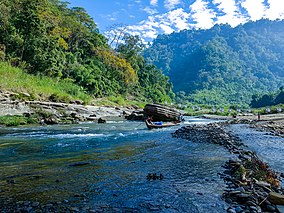| Sangu-Matamuhari | |
|---|---|
 Forest by the river sangu | |
| Location | Bandarban District, Chittagong Division, Bangladesh |
| Coordinates | 21°41′22″N 92°10′01″E / 21.68944°N 92.16694°E |
| Area | 23.32 km2 (9.00 sq mi) |
| Established | 2010 |
| Governing body | Bangladesh Forest Department |
Sangu-Matamuhari or Sangu Wildlife Sanctuary is a wildlife sanctuary—IUCN category II (habitat/species management area)—situated in Bandarban District, Chittagong Division, Bangladesh. It is part of the Sangu reserve forest. It is under the Lama Forest Division of the Bangladesh Forest Department.[1][2] Its bio-ecological zone is in Chittagong Hills and Chittagong Hill Tracts.[3]
It houses Bangladesh's richest wildlife resource after Sunderbans. It is famous for its remoteness and for its rich array of wildlife, including Asian elephants, gaurs, sambar deers, barking deers, serows, Asian black bears, sun bears, leopards, clouded leopards, Asian golden cats, marbled cats, leopard cats, binturongs, western hoolock gibbons, slow lorises, crab-eating macaques, capped langurs, reticulated pythons, Arakan forest turtles, Asian giant tortoises, great hornbills and spotted owlets. There have also been uncertain reports of vagrant tigers in the forest reserve by local indigenous people.[4]
It is a very remote and densely forested reserve. Thus the area remains largely undeveloped.[5]
- ^ "Wildlife Sanctuary". Bangladesh Forest Department. 18 February 2015. Retrieved 28 December 2015.
- ^ "Sangu Wildlife Sanctuary". ProtectedPlanet. 2014–2015. Retrieved 28 December 2015.
- ^ DeCosse, Philip J.; Thompson, Paul M.; Ahmad, Ishtiaq Uddin; Sharma, Ram A.; Mazumder, Azharul H., eds. (2012). "Protected Area Co-Management Where People and Poverty Intersect: Lessons from Nishorgo in Bangladesh" (PDF). Nishorgo Network. USAID.
- ^ Hance, Jeremy (1 March 2016). "Tiger country? Scientists uncover wild surprises in tribal Bangladesh". The Guardian.
- ^ সূচীপএ : নিয়মিত বিভাগ. Shaptahik (in Bengali). 2009. Retrieved February 27, 2016.
